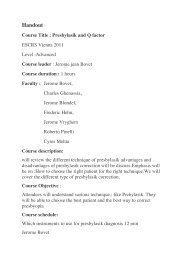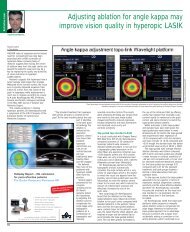ESCRS Guidelines on prevention, investigation and management of
ESCRS Guidelines on prevention, investigation and management of
ESCRS Guidelines on prevention, investigation and management of
Create successful ePaper yourself
Turn your PDF publications into a flip-book with our unique Google optimized e-Paper software.
In 1991, Bohigian was able to show in a retrospective analysis <strong>of</strong> a total <strong>of</strong> 19,269 cataract extracti<strong>on</strong>s that<br />
the incidence <strong>of</strong> endophthalmitis fell from 0.08 per cent to 0.03 per cent following the introducti<strong>on</strong> <strong>of</strong><br />
antisepsis with five per cent povid<strong>on</strong>e-iodine. This difference indicates a benefit but was not statistically<br />
significant <strong>and</strong> it is doubtful whether it can be attributed exclusively to povid<strong>on</strong>e-iodine antisepsis [56]. In<br />
the same year, Speaker <strong>and</strong> Menik<strong>of</strong>f in their study <strong>of</strong> 8,083 patients showed a significant difference, at the<br />
0.05 level, between the incidence <strong>of</strong> endophthalmitis with antisepsis using five per cent povid<strong>on</strong>e-iodine<br />
(0.06 per cent) <strong>and</strong> the c<strong>on</strong>trol group in which silver-protein soluti<strong>on</strong> was used (0.24 per cent) [18].<br />
The optimum c<strong>on</strong>centrati<strong>on</strong> <strong>of</strong> povid<strong>on</strong>e-iodine for use in pre-operative eye antisepsis has not been<br />
established at present. From the aspect <strong>of</strong> tolerability, there is evidence that even a 10 per cent povid<strong>on</strong>eiodine<br />
soluti<strong>on</strong> (without the additi<strong>on</strong> <strong>of</strong> detergent) is associated with low external corneal toxicity [177]. On<br />
the other h<strong>and</strong>, c<strong>on</strong>siderable side effects can be expected if even a five per cent povid<strong>on</strong>e-iodine soluti<strong>on</strong><br />
gets into the anterior chamber [145]. In animal experiments, the healing <strong>of</strong> skin wounds is significantly<br />
delayed even by two per cent povid<strong>on</strong>e-iodine [211], while it is tolerated by the sensitive nasociliary<br />
epithelium in a c<strong>on</strong>centrati<strong>on</strong> <strong>of</strong> 1.25 per cent [17] <strong>and</strong> by adult cartilage at <strong>on</strong>e per cent [16] without the<br />
efficacy in vitro being restricted at these diluti<strong>on</strong>s even with a large protein <strong>and</strong> blood load [38].<br />
Studies <strong>of</strong> the use <strong>of</strong> chlorhexidine digluc<strong>on</strong>ate <strong>on</strong> the c<strong>on</strong>junctiva or cornea give c<strong>on</strong>flicting results. A four<br />
per cent chlorhexidine soluti<strong>on</strong> induces corneal damage <strong>and</strong> should NOT be used [177], [200].<br />
Complicati<strong>on</strong>s have also been described for the 0.02 per cent chlorhexidine soluti<strong>on</strong> [188], but when used<br />
as l<strong>on</strong>g-term therapy (four times daily for eight weeks in the presence <strong>of</strong> a corneal ulcer presumed due to<br />
Acanthamoeba) rather than as single-use prophylaxis <strong>on</strong> an intact epithelium prior to surgery. On the other<br />
h<strong>and</strong>, pre-operative c<strong>on</strong>junctival irrigati<strong>on</strong> with 0.05 per cent chlorhexidine diacetate soluti<strong>on</strong> [107], as used<br />
by Per M<strong>on</strong>tan <strong>and</strong> all colleagues in Sweden, is found satisfactory.<br />
Applicati<strong>on</strong> <strong>of</strong> 10ml <strong>of</strong> five per cent povid<strong>on</strong>e-iodine <strong>on</strong>to a sp<strong>on</strong>ge pad <strong>on</strong>e hour prior to surgery clamped<br />
against the closed lids was associated with significantly fewer positive c<strong>on</strong>junctival cultures immediately<br />
prior to surgery (p = 0.02) <strong>and</strong> at the c<strong>on</strong>clusi<strong>on</strong> <strong>of</strong> the surgery (p = 0.05) compared with the applicati<strong>on</strong> <strong>of</strong><br />
two drops <strong>of</strong> five per cent povid<strong>on</strong>e-iodine [35].<br />
Clinicians should avoid use <strong>of</strong> large bottles <strong>of</strong> readily diluted povid<strong>on</strong>e-iodine or chlorhexidine whenever<br />
possible, <strong>and</strong> use single-use sachets or vials instead, as both antiseptics can become c<strong>on</strong>taminated with<br />
Ps. aeruginosa.<br />
In c<strong>on</strong>clusi<strong>on</strong>, it can be stated <strong>on</strong> the basis <strong>of</strong> the available clinical studies that <strong>on</strong>ly povid<strong>on</strong>e-iodine in a<br />
c<strong>on</strong>centrati<strong>on</strong> <strong>of</strong> five per cent in BSS or isot<strong>on</strong>ic saline can be recommended at present as the pre-operative<br />
antiseptic <strong>of</strong> choice. It has not been established whether similar results can be obtained with a lower<br />
c<strong>on</strong>centrati<strong>on</strong>, such as 2.5 or 1.25 per cent. However, a significant effect for a reducti<strong>on</strong> in the c<strong>on</strong>junctival<br />
bacterial count after surgery has been c<strong>on</strong>firmed when 1.25 per cent povid<strong>on</strong>e-iodine was used [28].<br />
Povid<strong>on</strong>e iodine soluti<strong>on</strong> c<strong>on</strong>taining a detergent must NOT be used as it coagulates the cornea irreversibly.<br />
2.3 Antibiotics<br />
Pre-operative prophylaxis<br />
Pre-operative topical antibiotic prophylaxis appears rati<strong>on</strong>al to reduce the number <strong>of</strong> bacteria in the<br />
c<strong>on</strong>junctival sac. Various antibiotics have been used in the past including fluoroquinol<strong>on</strong>es,<br />
chloramphenicol, aminoglycosides, fusidic acid <strong>and</strong> combinati<strong>on</strong> products <strong>of</strong> polymyxin / bacithracin /<br />
neomycin, but their use, including current use <strong>of</strong> topical fluoroquinol<strong>on</strong>es, is not yet scientifically proven to<br />
reduce the rate <strong>of</strong> post-operative endophthalmitis [53], [61], [77], [146], [178]. However, a recent<br />
retrospective analysis has suggested a lower endophthalmitis rate following use <strong>of</strong> topical <strong>of</strong>loxacin compared<br />
to topical cipr<strong>of</strong>loxacin [86].<br />
The r<strong>and</strong>omised, placebo-c<strong>on</strong>trolled prospective multi-centre <str<strong>on</strong>g>ESCRS</str<strong>on</strong>g> study has investigated if use <strong>of</strong> perioperative<br />
topical lev<strong>of</strong>loxacin, which reaches significantly higher c<strong>on</strong>centrati<strong>on</strong>s in the anterior chamber than<br />
<strong>of</strong>loxacin <strong>and</strong> cipr<strong>of</strong>loxacin [2], [3], [7], can prevent post-operative endophthalmitis. Patients were<br />
administered <strong>on</strong>e drop <strong>of</strong> lev<strong>of</strong>loxacin 0.5 per cent soluti<strong>on</strong> <strong>on</strong>e hour before surgery, <strong>on</strong>e drop 30 minutes<br />
before surgery <strong>and</strong> three drops at five-minute intervals immediately following surgery. Dosing was interrupted<br />
until the following day to study the effect <strong>of</strong> peri-operative prophylaxis <strong>on</strong>ly. Although there appeared to be<br />
some benefit from the use <strong>of</strong> peri-operative lev<strong>of</strong>loxacin, the effect was smaller than for intracameral<br />
injecti<strong>on</strong> <strong>of</strong> cefuroxime (see below) <strong>and</strong> did not reach statistical significance [5]. To maintain an adequate<br />
level <strong>of</strong> lev<strong>of</strong>loxacin in the anterior chamber it may be c<strong>on</strong>sidered c<strong>on</strong>tinuing to dose every two hours postoperatively<br />
<strong>on</strong> the day <strong>of</strong> surgery [43].<br />
9





